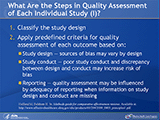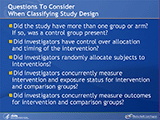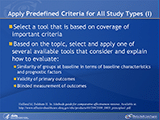- Home
- Slides
- Home
- Tools and Resources
- Research Summaries for Consumers, Clinicians, and Policymakers
- Search for Research Summaries, Reviews, and Reports
- Research Available for Comment
- Submit a Suggestion for Research
- Submit Scientific Information Packets
- Comparative Effectiveness Research Grant and ARRA Awards
- News and Announcements
- What Is Comparative Effectiveness Research
- Who Is Involved in the Effective Health Care Program
- What Is the Effective Health Care Program
Slides
Slides: 1–12 of 72
Comparative Effectiveness of CDI Prevention Strategies
Consider the Contribution of an Individual Study to the Body of Evidence
Presentation: Assessing the Quality of Individual Studies
Keywords: internal validity | study design | body of evidence | key questions | applicability | generalizability
What Are the Steps in Quality Assessment of Each Individual Study (I)?
Presentation: Assessing the Quality of Individual Studies
Keywords: quality assessment | selection criteria | study design
Questions To Consider When Classifying Study Design
Presentation: Assessing the Quality of Individual Studies
Keywords: study design
Apply Predefined Criteria for All Study Types (I)
Presentation: Assessing the Quality of Individual Studies
Keywords: study design
Steps in Quality Assessment
Presentation: Assessing the Quality of Individual Studies Quiz
The Studies
Outline of Material
Spectrum of Possible Comparisons (2 of 3)
Conclusions
Keywords: conclusion | comparator selection
Model Selection
Instrumental Variables
Your slide tray is being processed.


 E-mail Updates
E-mail Updates










